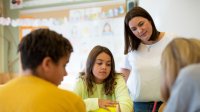A Math Word Problem Framework That Fosters Conceptual Thinking
This strategy for selecting and teaching word problems guides students to develop their understanding of math concepts.
Your content has been saved!
Go to My Saved Content.Word problems in mathematics are a powerful tool for helping students make sense of and reason with mathematical concepts. Many students, however, struggle with word problems because of the various cognitive demands. As districtwide STEAM professional development specialists, we’ve spent a lot of time focusing on supporting our colleagues and students to ensure their success with word problems. We found that selecting the right word problems, as well as focusing on conceptual understanding rather than procedural knowledge, provides our students with real growth.
As our thinking evolved, we began to instill a routine that supports teaching students to solve with grit by putting them in the driver’s seat of the thinking. Below you’ll find the routine that we’ve found successful in helping students overcome the challenges of solving word problems.
Not all word problems are created equal
Prior to any instruction, we always consider the quality of the task for teaching and learning. In our process, we use word problems as the path to mathematics instruction. When selecting the mathematical tasks for students, we always consider the following questions:
- Does the task align with the learning goals and standards?
- Will the task engage and challenge students at an appropriate level, providing both a sense of accomplishment and further opportunities for growth?
- Is the task open or closed? Open tasks provide multiple pathways to foster a deeper understanding of mathematical concepts and skills. Closed tasks can still provide a deep understanding of mathematical concepts and skills if the task requires a high level of cognitive demand.
- Does the task encourage critical thinking and problem-solving skills?
- Will the task allow students to see the relevance of mathematics to real-world situations?
- Does the task promote creativity and encourage students to make connections between mathematical concepts and other areas of their lives?
If we can answer yes to as many of these questions as possible, we can be assured that our tasks are rich. There are further insights for rich math tasks on NRICH and sample tasks on Illustrative Mathematics and K-5 Math Teaching Resources.
Developing conceptual understanding
Once we’ve selected the rich math tasks, developing conceptual understanding becomes our instructional focus. We present students with Numberless Word Problems and simultaneously use a word problem framework to focus on analysis of the text and to build conceptual understanding, rather than just memorization of formulas and procedures.
- First we remove all of the numbers and have students read the problem focusing on who or what the problem is about; they visualize and connect the scenario to their lives and experiences.
- Next we have our students rewrite the question as a statement to ensure that they understand the questions.
- Then we have our students read the problem again and have them think analytically. They ask themselves these questions: Are there parts? Is there a whole? Are things joining or separating? Is there a comparison?
- Once that’s completed, we reveal the numbers in the problem. We have the students read the problem again to determine if they have enough information to develop a model and translate it into an equation that can be solved.
- After they’ve solved their equation, we have students compare it against their model to check their answer.
Collaboration and workspace are key to building the thinking
To build the thinking necessary in the math classroom, we have students work in visibly random collaborative groups (random groups of three for grades 3 through 12, random groups of two for grades 1 and 2). With random groupings, we’ve found that students don’t enter their groups with predetermined roles, and all students contribute to the thinking.
For reluctant learners, we make sure these students serve as the scribe within the group documenting each member’s contribution. We also make sure to use nonpermanent vertical workspaces (whiteboards, windows [using dry-erase markers], large adhesive-backed chart paper, etc.). The vertical workspace provides accessibility for our diverse learners and promotes problem-solving because our students break down complex problems into smaller, manageable steps. The vertical workspaces also provide a visually appealing and organized way for our students to show their work. We’ve witnessed how these workspaces help hold their attention and improve their focus on the task at hand.
Facilitate and provide feedback to move the thinking along
As students grapple with the task, the teacher floats among the collaborative groups, facilitates conversations, and gives the students feedback. Students are encouraged to look at the work of other groups or to provide a second strategy or model to support their thinking. Students take ownership and make sense of the problem, attempt solutions, and try to support their thinking with models, equations, charts, graphs, words, etc. They work through the problem collaboratively, justifying their work in their small group. In essence, they’re constructing their knowledge and preparing to share their work with the rest of the class.
Word problems are a powerful tool for teaching math concepts to students. They offer a practical and relatable approach to problem-solving, enabling students to understand the relevance of math in real-life situations. Through word problems, students learn to apply mathematical principles and logical reasoning to solve complex problems.
Moreover, word problems also enhance critical thinking, analytical skills, and decision-making abilities. Incorporating word problems into math lessons is an effective way to make math engaging, meaningful, and applicable to everyday life.
